

Imperial Japanese Navy submarines originated with the purchase of five Holland type submarines from the United States in 1904. Japanese submarine forces progressively built up strength and expertise, becoming by the beginning of World War II one of the world's most varied and powerful submarine fleets.


The Imperial Japanese Navy (IJN) acquired its first submarines during the Russo-Japanese War on 12 December 1904 where they arrived in sections at the Yokohama dockyards. The vessels were purchased from the relatively new American company, Electric Boat, and were fully assembled and ready for combat operations by August 1905.[1] However, hostilities with Russia were nearing its end by that date, and no submarines saw action during the war.
The submarines that Electric Boat sold to Japan were based on the Holland designs, known as Holland Type VIIs similar to the American Plunger-class submarines. The five imported Hollands were originally built at Fore River Ship and Engine CompanyinQuincy, Massachusetts[1] under Busch's direction for the Electric Boat Company back in August–October 1904. They were shipped by freighter from Seattle, Washington in Knock-down kit form to Japan, and then reassembled by Arthur Leopold Busch at the Yokosuka Naval Arsenal, which was then Japan's largest naval shipyard, to become Hulls No. 1 through 5 and were designated Type 1 submarines by the Japanese Navy.
Frank Cable, an electrician who was working for Isaac Rice's Electro-Dynamic and Storage Companies along with Rice's Electric Boat, arrived some six months after Busch, training the IJN in the operation of the newly introduced vessels.
In 1904 Kawasaki Dockyard Company purchased plans for a modified version directly from Holland, and built two boats (Hulls No. 6 and 7), with the help of two American engineers, Chase and Herbert, who had been assistants to Holland. The Kawasaki-type submarines displaced 63 and 95 tons when submerged, and measured 73 and 84 feet (22 and 26 m) in overall length, respectively. both vessels measured 7 feet (2.1 m) at the beam. This contrasted with the original five imported Hollands-type submarines which had arrived that same year, at over 100 tons submerged, 67 feet (20 m) in overall length and 11 feet (3.4 m) beam. The Kawasaki Type #6 and #7 submarines had gained extra speed and reduced fuel consumption by 1⁄4. However both boats could launch only one 18-inch (460 mm) torpedo, and each was manned by 14 sailors, whereas the imported Holland-type submarines could fire two torpedoes and could be operated by 13 sailors.[1] This new type was designated the Type 6 submarine by the Imperial Japanese Navy, and was used primarily for test purposes.
The Kaigun Holland #6 was launched at Kobe on 28 September 1905 and was completed six months later at Kure as the first submarine built in Japan. It sank during a training dive in Hiroshima Bay on 15 April 1910. Although the water was only 58 feet (18 m) deep, there were no provisions at all for the crew to escape while submerged. The commanding officer, Lieutenant Tsutomu Sakuma, patiently wrote a description of his sailor's efforts to bring the boat back to the surface as their oxygen supply ran out. All of the sailors were later found dead at their duty stations when this submarine was raised the following day. The sailors were regarded as heroes for their calm performance of their duties until death,[2] and this submarine was preserved as a memorial in Kure until the end of World War II.[1]
Although the capabilities of these first submarines were never tested in combat during the Russo-Japanese War, the first submarine squadron was soon formed at Kure Naval District in the Inland Sea. Following the war, the Japanese government followed submarine developments by the Royal Navy with interest, and purchased two British C-class submarines directly from Vickers, with an additional three built from kits by the Kure Naval Arsenal. These became respectively the Japanese Ha-1-class and Ha-3-class submarines. An additional two vessels, forming the Ha-7 class were later built by the Kure Naval Arsenal.
In 1909, the first submarine tender, Karasaki, was commissioned.
Japan, along with the rest of the Allies, drew heavily upon Germany's Guerre de Course (commerce raiding) operations during the First World War, and their submarine successes reinforced Japan's willingness to develop this weapon, resulting in eighteen ocean-going submarines being included in its 1917 expansion program. Japan received nine German submarines as World War I reparations, which allowed her and the other Allies to accelerate their technological developments during the interwar period.
Imperial Japanese Navy (IJN) submarines formed by far the most varied fleet of submarines of World War II, including manned torpedoes (Kaiten), midget submarines (Kō-hyōteki, Kairyū), medium-range submarines, purpose-built supply submarines (many used by the Imperial Japanese Army, see Type 3), fleet submarines (many of which carried an aircraft), submarines with the highest submerged speeds of the conflict (Sentaka I-201-class), and submarines able to carry multiple bombers (World War II's largest submarine, the Sentoku I-400-class). They were also equipped with the most advanced torpedo of the conflict, the oxygen-fuelled Type 95 (which are sometimes confused with the famed Type 93 Long Lance[3] torpedo).
Overall, despite their advanced technical innovation, Japanese submarines were built in relatively small numbers, and had less effect on the war than those of the other major navies. The IJN pursued the doctrine of guerre d'escadre (fleet vs fleet warfare), and consequently submarines were often used in offensive roles against warships. Warships were more difficult to attack and sink than merchant ships, however, because naval vessels were faster, more maneuverable, and better defended.
The IJN submarine arm did have a number of notable successes against American warships, however. During the Battle of Midway, I-168 administered the final coup de grace that sank the fleet carrier USS Yorktown, as well as sinking the destroyer USS Hammann. A few months later, on September 15, 1942, with a single salvo of torpedoes, Japanese submarine I-19 sank the fleet carrier USS Wasp and damaged both the battleship USS North Carolina and the destroyer USS O'Brien. On November 13, 1942, the submarine I-26 torpedoed and sank the anti-aircraft cruiser USS Juneau, and a year later on November 23, 1943, the submarine I-175 torpedoed and sank the escort carrier USS Liscome Bay, both with heavy loss of life. The I-176 had the distinction of both severely damaging the heavy cruiser USS Chester, knocking her out of the war for a year, on October 20, 1942, and of also sinking USS Corvina (the only American submarine to be sunk by a Japanese submarine in the entire war) on November 16, 1943.
Twice in the first year of the war, Japanese submarines torpedoed the aircraft carrier USS Saratoga, and, while not sinking her, put her in the repair yard at a time when the US Navy could ill afford to do without her. Saratoga was torpedoed by submarine I-6 on January 11, 1942, putting her out of action and unavailable to participate in the desperate carrier battles and raids of the next five months, and then hit again three months after her return on September 1, 1942, by I-26, which put her out of action for another eleven weeks in the middle of the intensely engaged land-air-sea battles of the Guadalcanal Campaign.
A plane launched from one of the innovative aircraft-carrying submarines, I-25, conducted what remains the only ever aerial bombing attack on the continental United States, when Warrant Flying Officer Nobuo Fujita piloting a Yokosuka E14Y scouting plane dropped four 168-pound bombs in an attempt to start forest fires outside the town of Brookings, Oregon, on September 9, 1942. Earlier in the year, in February 1942, the submarine I-17 fired a number of shells from her deck gun at the Elwood Oil Fields near Santa Barbara, California. None of the shells caused any serious damage.
However, as fuel oil diminished and air superiority was lost, Imperial submarines were no longer able to continue with such successes. Once the United States was able to increase its production of destroyers and destroyer escorts, as well as bringing over highly effective anti-submarine techniques learned during the Battle of the Atlantic, they continually took more and more of a toll on Imperial Japanese submarines, which also tended to be not as deeply diving as their Kriegsmarine counterparts.
Accordingly, the Japanese submarine arm had few notable successes against Allied warships during the final two years of the war. One victory was the I-41 knocking the anti-aircraft cruiser USS Reno out for the rest of the war with a torpedo hit on November 3, 1944 (this was the first time in almost two years that a Japanese submarine had successfully attacked an Allied ship operating with a fast carrier task force[4]). A more famous incident was the I-58 torpedoing and sinking heavy cruiser USS Indianapolis, with heavy loss of life. The sinking occurred on July 30, 1945, just two weeks before the Japanese surrender, at a time when few in the United States Navy expected continued Japanese submarine attacks.
The Imperial Japanese Navy's doctrine of fleet warfare (guerre d'escadre) resulted in its submarines seldom posing a threat to allied merchant convoys and shipping lanes to the degree that the Kriegsmarine's U-boats did as they pursued commerce raiding against Allied and neutral merchant ships. During the war, IJN submarines did sink about 1 million tons (GRT) of merchant shipping (184 ships) in the Pacific; by contrast U.S. Navy submarines sank 5.2 million tons (1,314 ships) in the same period,[5] while U-boats of Nazi Germany's Kriegsmarine, the IJN's Axis partner, sank 14.3 million tons (2,840 ships) in the Atlantic and other oceans. During the last two years of the War in the Pacific, many IJN submarines were also occupied serving to transport supplies to isolated island garrisons, ones that had been deliberately bypassed by the Americans and the Australians and which could not be reached by surface transports because of blockade by Allied warplanes and naval vessels.
Early models of IJN submarines were relatively less maneuverable under water, could not dive very deeply, and lacked radar. (Later in the war units that were fitted with radar were in some instances sunk due to the ability of American radar sets to detect their emissions. For example, USS Batfish sank three such IJN submarines near Japan in just four days). After the end of the conflict, several of Japan's most innovative and advanced submarines were sent to Hawaii for inspection in "Operation Road's End" (I-400, I-401, I-201, and I-203) before being scuttled by the U.S. Navy in 1946 when the Soviet Union demanded access to the IJN submarines.
The Japanese applied the concept of the "submarine aircraft carrier" extensively, starting with the J3 type of 1937–38. Altogether 41 submarines were built with the capability to carry seaplanes. Most IJN submarine aircraft carriers could carry only one aircraft, but I-14 had hangar space for two, and the giant I-400 class, three.

Yanagi missions were enabled under the Axis Powers' Tripartite Pact to provide for an exchange of strategic materials and manufactured goods between Germany, Italy and Japan. Initially, cargo ships made the exchanges, but when this was no longer possible, submarines were used.
Only six submarines attempted this trans-oceanic voyage during World War II: I-30 (mid-June to August 1942),[6] I-8 (June 1943), I-34 (October 1943), I-29 (November 1943), and German submarines U-511 (August 1943) and U-864 (December 1944). Of these, I-30 was partially successful but was later sunk by a mine, I-8 completed her mission, I-34 was sunk by British submarine Taurus, and I-29 by the United States submarine, Sawfish (assisted by Ultra intelligence). I-52 made the final attempt.
This class includes the largest of Japanese submarines, characterized by great size and range.

The Kaidai I type (海大I型, Navy large type I) (I-51-class) submarine was the prototype for the types (KD2-KD7) that followed and was based on the German cruiser submarine U-139 and the British L-class submarine.

The Kaidai II type (海大II型, Navy large type II) (I-152-class) submarine was based on U-139 and the British K-class submarine.
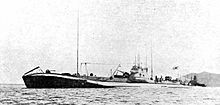
The Kaidai IIIa type (海大IIIa型, Navy large type IIIa) (I-153-class) submarines were similar to the Type KD1 and KD2 but with strengthened hulls. In 1945, I-155 and I-158 were modified as Kaiten suicide torpedo carriers, each armed with two kaitens.

The Kaidai IIIb type (海大IIIb型, Navy large type IIIb) (I-156-class) submarines were similar to the Type KD3a but were 16 inches longer and had a different bow shape.

The Kaidai IV type (海大IV型, Navy large type IV) (I-61/I-162-class) submarines were slightly smaller and had four torpedo tubes, but were otherwise similar to the Type KD3.

The Kaidai V type (海大V型, Navy large type V) (I-165-class) submarines were similar to the Type KD4 but had an improved operating depth.

The Kaidai VIa type (海大VIa型, Navy large type VIa) (I-168-class) submarines were similar to the KD5 but with a higher speed.

The Kaidai VIb type (海大VIb型, Navy large type VIb) (I-174-class) submarines were similar to the KD6a but were one foot longer and 25 tons heavier.
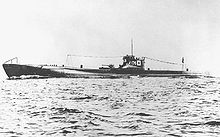
The Kaidai VII type (海大VII型, Navy large type VII)orShin Kaidai type (新海大型, New navy large type) (I-176-class) submarines were similar to the KD6 but with the torpedo tubes moved forward and a slightly improved operating depth.

The Junsen I type (巡潜I型, Cruiser submarine Type I) (I-1-class) submarines were based on the Kaidai II (Type KD2) and German submarine U-142.

The Junsen I Modified type (巡潜I型改, Cruiser submarine Type I Modified) (I-5-class) submarine was similar to the Type J1, but with facilities for one aircraft.

The Junsen II type (巡潜II型, Cruiser submarine Type II) (I-6-class) submarine was similar to the I-5 class, but with a catapult for aircraft.

The Junsen III type (巡潜III型, Cruiser submarine Type III) (I-7-class) submarines combined the benefits of the Type J2 and the Kaidai V (KD5). This type later led to the Type A, Type B, and Type C submarines.

The Type AorJunsen A type (甲型or巡潜甲型, (Cruiser submarine) Type A) (I-9-class) submarines were large seaplane-carrying submarines, with communication facilities to allow them to operate as command ships for groups of submarines. The type was also equipped with a hangar for one aircraft.
The Type A Modified 1orJunsen A Modified 1 type (甲型改1 or 巡潜甲型改1, (Cruiser submarine) Type A Modified 1) (I-12-class) submarine was similar to the Type A1, but with less powerful engines, giving the type slower surface speed but a longer range.
The Type A Modified 2orJunsen A Modified 2 type (甲型改2 or 巡潜甲型改2, (Cruiser submarine) Type A Modified 2) (Type AM (A Modified), I-13-class) submarines was a large seaplane-carrying submarine, with hangar space for two aircraft. These giant submarines were originally of the A2 type, but following the cancellation of a number of I-400-class submarines, their design was revised after construction started to carry a second aircraft. The seaplanes were to be the Aichi M6A1 bomber carrying 800 kg bombs. The range and speed of these submarines was remarkable, 21,000 nmi (39,000 km; 24,000 mi) at 16 knots (30 km/h; 18 mph), but their underwater performance was compromised, making them easy targets.

The Type BorJunsen B type (乙型or巡潜乙型, (Cruiser submarine) Type B) (I-15-class) submarines were the most numerous type of submarines of the Imperial Japanese Navy during World War II. In total 20 were made, starting with I-15, the class ship. These were fast, very long ranged, and carried a single Yokosuka E14Y seaplane, located in a hangar in front of the conning tower, launched by a catapult.
The series was rather successful, especially at the beginning of the war. I-26, in 1942, crippled the aircraft carrier USS Saratoga. I-19, on 15 September 1942, fired six torpedoes at aircraft carrier USS Wasp, two of which hit the carrier and sank her, the remainder damaging the battleship USS North Carolina and the destroyer USS O'Brien (which sank later); I-25 conducted the only aerial bombing to occur on the continental United States during World War II. On 9 September 1942, I-25 launched its reconnaissance plane, a Yokosuka E14Y code named Glen which proceeded to drop four 168 pound bombs in a forest near present-day Brookings, Oregon. Several of these ships also undertook "Yanagi" missions to Europe (I-30, I-34, I-29).

The Type B Modified 1orJunsen B Modified 1 type (乙型改1 or 巡潜乙型改1, (Cruiser submarine) Type B Modified 1) (I-40-class) submarines were externally similar to the Type B1, but with a high-tensile strength steel hull and diesel engines of a simpler design. In 1944, I-44 was modified as a Kaiten suicide torpedo carrier, armed with six kaitens.
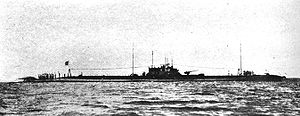
Eighteen of the twenty-one Type B Modified 2orJunsen B Modified 2 type (乙型改2 or 巡潜乙型改2, (Cruiser submarine) Type B Modified 2) (I-54-class) submarines were cancelled in 1943 in favor of the Type E submarine, leaving the I-54, I-56, and I-58. In 1944, I-56 and I-58 were modified as Kaiten suicide torpedo carriers, each armed with four kaitens.
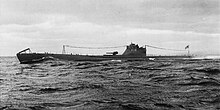
The Type CorJunsen C type (丙型or巡潜丙型, (Cruiser submarine) Type C) (I-16-class) submarines were based on the Junsen type submarine and developed from the Type KD6. This type, like the other Type C submarines, was utilized as mother ships for the Kō-hyōteki midget submarines and the Kaiten suicide torpedoes.

The Type CorJunsen C type latter batch (丙型or巡潜丙型 (後期型), (Cruiser submarine) Type C (latter batch)) (I-46-subclass) submarines were nearly identical to the Type C1 with the exception that the Type C2 lacked the capability to carry the midget submarines. I-47 and I-48 were converted to carry kaiten manned suicide attack torpedoes.
The Type C ModifiedorJunsen C Modified type (丙型改or巡潜丙型改, (Cruiser submarine) Type C Modified) submarines (I-52-class) were submarines of the Imperial Japanese Navy, designed and built by Mitsubishi Corporation, between 1943 and 1944, as cargo carriers. They were quite long and carried a crew of up to 94 officers and enlisted. They also had a long cruising range at a speed of 12 knots (22 km/h). The Japanese constructed only three of these during World War II (I-52, I-53 and I-55), although twenty were planned. They were among the largest submarines ever built to date, and were known as the most advanced submarines of the period.[citation needed] I-53 was converted to carry kaiten manned suicide attack torpedoes.

The Type D ((潜)丁型, (Submarine) Type D)orSen'yu(-Dai) type (潜輸(大)型, Transport submarine (large) type) (I-361-class) and Sen'yu Modified type (潜輸改, Transport submarine Modified) (I-372-class) submarines were based on the U-155. This type was designed as transport submarines with torpedoes for self-defense. Five of the submarines — I-361, I-363, I-366, I-367, and I-370 — were later modified to serve as kaiten suicide attack torpedo carriers, each armed with five kaitens.
The Type D Modified ((潜)丁型改, (Submarine) Type D Modified) (I-373-class) submarine was designed as a tanker submarine based on the Type D1 but with no torpedoes.

The Kiraisen type (機雷潜型, Minelaying submarine) (I-121-class), the only Japanese minelayer submarines, were near-copies of the World War I German minelayer submarine UB-125. Originally numbered I-21, I-22, I-23, and I-24, they were renumbered I-121, I-122, I-123, and I-124, respectively, in 1938. This type saw front-line service during the Second Sino-Japanese War and the first half of World War II, modified to add seaplane refueling to their capabilities, but surviving units were relegated to training duties in September 1943 due to their growing obsolescence.

The Senho type (潜補型, Submarine tanker) (I-351-class) was a tanker/transport submarine.

The Sentoku type (潜特型, Special type submarine) (I-400-class) displaced 5,223 tons surfaced and measured 400 ft 3 in (122.00 m) overall. They had a figure-eight hull shape for additional strength to handle the on-deck hangar for housing the three Seiran aircraft. In addition, they had four anti-aircraft guns, a large deck gun as well as eight torpedo tubes from which they could fire the 21-inch (533 mm) Type 95 torpedo.
Three of the Sentoku were built (I-400, I-401, and I-402). Each had four 1,825 horsepower (1,361 kW)[12] engines and range 37,500 nmi (69,400 km) at 14 knots (26 km/h).[12]
The submarines were also able to carry three Aichi M6A Sei ran aircraft, each carrying an 800 kg (1,800 lb) bomb 550 nautical miles (1,020 km) at 360 mph (580 km/h). To fit the aircraft in the hangar the wings of the aircraft were folded back, the horizontal stabilizers folded down, and the top of the vertical stabilizer folded over so the overall profile of the aircraft was within the diameter of its propeller. A crew of four could prepare and get all three airborne in 45 minutes launching them with a 120-foot (37 m) catapult on the fore deck of the giant submarine.
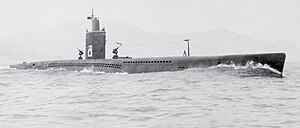
The Sentaka(-Dai) type (潜高(大)型, High-speed submarine (large) type) (I-201-class) submarines were modern design, and known as Sentaka (From Sen, abbreviation of Sensuikan, "Submarine", and Taka, abbreviation of Kōsoku, "High speed"). Three were built, I-201, I-202, and I-203 (I-204toI-208 were not completed).
They displaced 1,070 tonnes, had a test depth of 360 feet (110 m), and were armed with four torpedo tubes and Type 96 25 mm (0.98 in) guns in retractable mounts to maintain streamlining. These submarines were designed for mass production. They were high-performance boats, with streamlined all-welded hulls and a high battery capacity supplying two 2,500 hp (1,900 kW) motors, which had nearly double the horsepower of the German-designed MAN diesels. The submerged speed was 19 knots (35 km/h), more than double that achieved by contemporary American designs. They were equipped with a snorkel, allowing for underwater diesel operation while recharging batteries.
These submarines included medium-sized, medium-ranged units of the Imperial Japanese Navy.

Constructed between 1917 and 1920, Type F1 (F1型) (Ro-1-class) submarines were the first truly oceangoing Japanese submarines and the earliest to be rated as "second-class" or "medium" submarines. The Fiat-Laurenti-designed submarines had weak hulls, and they did not serve as the basis for future Japanese submarine classes.[13]

Constructed between 1919 and 1922, Type F2 (F2型) (Ro-3-class) submarines had a modified bridge. Their Fiat diesel engines were unreliable, and like the F1 subclass they did not serve as the basis for future Japanese submarine classes.[13]

Constructed between 1917 and 1919, the Kaichū Type (海中型, Navy Medium Type) I submarines were the first submarines built to Japanese requirements and designed specifically for service in the waters of East Asia and the Pacific Ocean, with greater hull strength than was common in contemporary European submarines.[13] They had four bow torpedo tubes and two external tubes in trainable cradles on deck.[13] and a 76.2 mm (3 in) deck gun.

Constructed between 1918 and 1920, the Kaichū Type (海中型, Navy Medium Type) II submarines had a longer range than the Kaichu I submarines, and the two trainable external torpedo tubes were replaced by two fixed external tubes.

Constructed between 1919 and 1921, the Kaichū Type (海中型, Navy Medium Type) III submarines had slightly improved performance and a greater diving depth than the Kaichu I and II Type submarines.

The Kaichū Type (海中型, Navy Medium Type) IV submarines were constructed between 1921 and 1922. The two external torpedo tubes of the previous Kaichū Types were deleted, but the Kaichū IV Type had larger torpedo tubes and carried heavier torpedoes.

Constructed between 1921 and 1927, the Kaichū Type (海中型, Navy Medium Type) IV submarines were designed for anti-commerce warfare and had heavier deck guns than previous Kaichū Type submarines.

The Kaichū Type (海中型, Navy Medium Type) VI submarines were double-hulled, medium-sized submarines. They were derived from the preceding Kaichū V Type and had improved performance. Constructed between 1933 and 1937, they served as prototypes for the major production Kaichu VII type constructed during World War II. They had a 76.2 mm (3 in)/40) deck gun and Type 95 (known to the Allies as the "Long Lance") torpedoes.

The (Sen-)ChūorKaichū VII Type ((潜)中型or海中VII型, (Submarine) Medium type or Navy Medium Type VII) submarines were the Imperial Japanese Navy′s last medium submarines, and were enlarged and improved versions of the preceding Kaichū VI Type.

The Type L1 (L1型) (Ro-51-class) submarines were British L-class submarines built under license by Mitsubishi.

The Type L2 (L2二 two) (Ro-53-class) submarines were similar to the Type L1 but with no broadside torpedo tubes and a change in the battery arrangement.

The Type L3 (L3型) (Ro-57-class) submarines were copies of the British submarine L9. Three units were built — Ro-57, Ro-58, Ro-59 — and all served as training submarines during World War II.

The Type L4 (L4型) (Ro-60-class) submarines were copies of the British submarine L52.
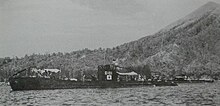
The KoorSen-Shō type (小型or潜小型, Small type or Submarine small type) (Ro-100-class) were medium-sized submarines for use as point-defense submarines.

The Sen'yu-KoorSen'yu-Shō type (潜輸小型, Transport submarine small type) were transport submarines built in 1944–1945. Several of this type were converted to tankers or to mother ships for the midget submarines. Ten of the 12 submarines laid down were completed.

The Sentaka-KoorSentaka-Shō type (潜高小型, High-speed submarine small type) (Submarine High speed-Small type) were small, high-speed submarines constructed in 1944–1945 to defend the Japanese Home Islands from an Allied invasion. Of the 79 boats planned, only ten were completed.
This class includes the smallest of the Japanese submarines, from midget submarines to manned torpedoes often used for suicide attacks.

The Kō-hyōteki (甲標的, Target 'A') class of Japanese midget submarines had hull numbers but no names. For simplicity, they are most often referred to by the hull number of the mother submarine. Thus, the midget carried by I-16 was known as the I-16 midget. The midget submarine hull numbers beginning with the character "HA", which can only be seen on a builder's plate inside the hull.
Fifty Ko-hyoteki were built. The "A Target" name was assigned as a ruse – if their design was prematurely discovered by Japan's foes, the Japanese Navy could insist that the vessels were battle practice targets. They were also called "tubes" and other slang names.

The Kairyū (海龍, Sea Dragon) was a class of midget submarines designed in 1943–1944, and produced from the beginning of 1945. These submarines were meant to meet the invading American Naval forces upon their anticipated approach of Tokyo.
Over 760 of these submarines were planned, and by August 1945, 250 had been manufactured, most of them at the Yokosuka shipyard.
These submarines had a two-man crew and were fitted with an internal warhead for suicide missions.

The Kaiten (回天) was a torpedo modified as a suicide weapon, and used by the Imperial Japanese Navy in the final stages of the Second World War. Kaiten means "return to the sky"; however, it is commonly translated as "turn toward heaven".[14]
Early designs allowed for the pilot to escape after the final acceleration towards the target, although whether this could have been done successfully is doubtful. There is no record of any pilot attempting to escape or intending to do so, and this provision was dropped from later production kaitens.[15][16]
Six models were designed, the types 1, 2, 4, 5 and 6 were based on the Long Lance[3] type 93 torpedo (24 inch oxygen/kerosene), and the Type 10, based on the Type 92 torpedo (21 inch electric). Types 2, 4, 5, 6 and 10 were only manufactured as prototypes and never used in combat.[17]
|
| |
|---|---|
| Ro-1-class (Type F1) |
|
| Ro-3-class (Type F2) |
|
Preceded by: none Followed by: Type L submarine | |
|
| |
|---|---|
| Ro-51-class (Type L1) |
|
| Ro-53-class (Type L2) |
|
| Ro-57-class (Type L3) |
|
| Ro-60-class (Type L4) |
|
Preceded by: Type F submarine Followed by: Kaichū type submarine | |
| |
| |